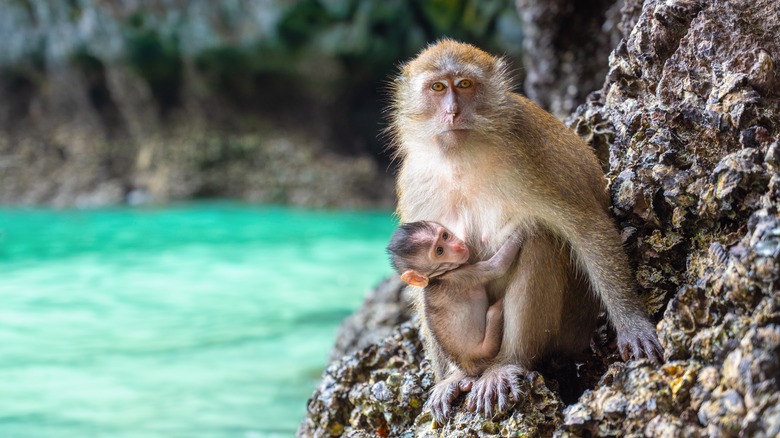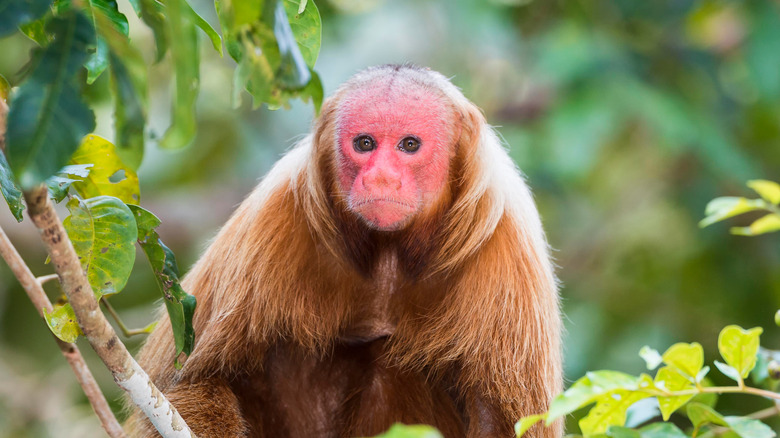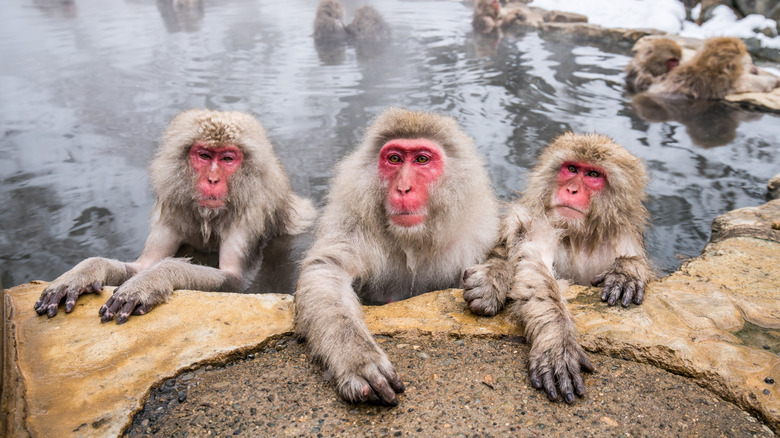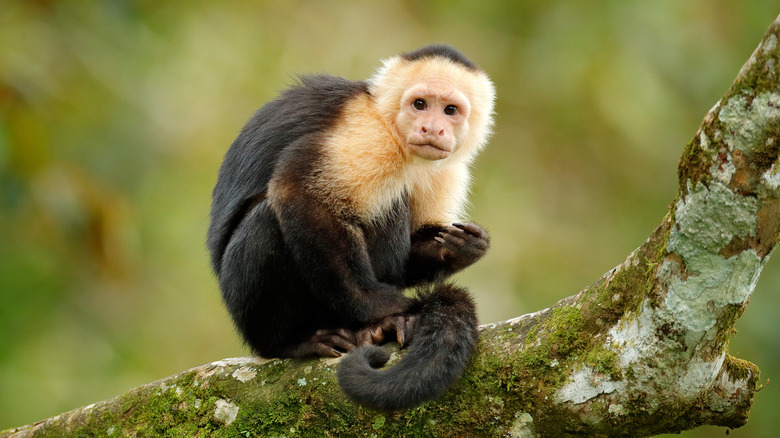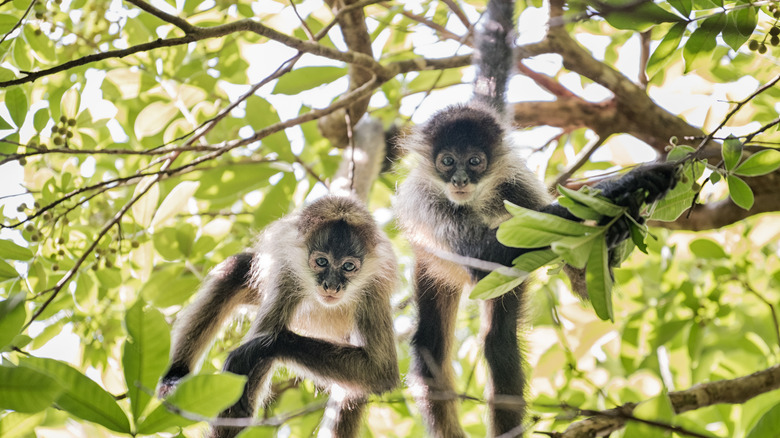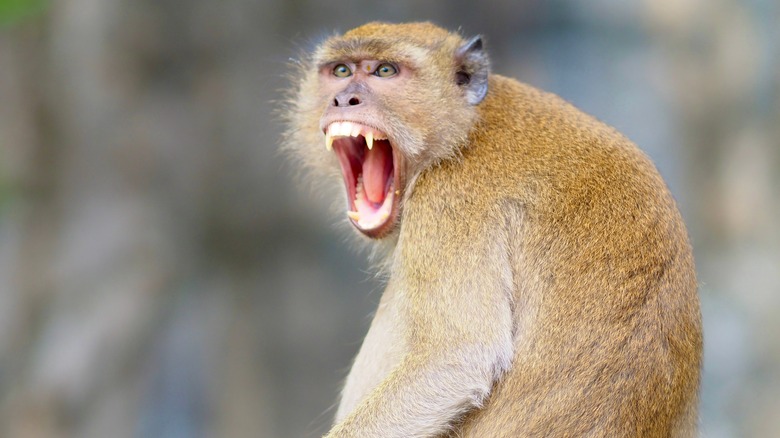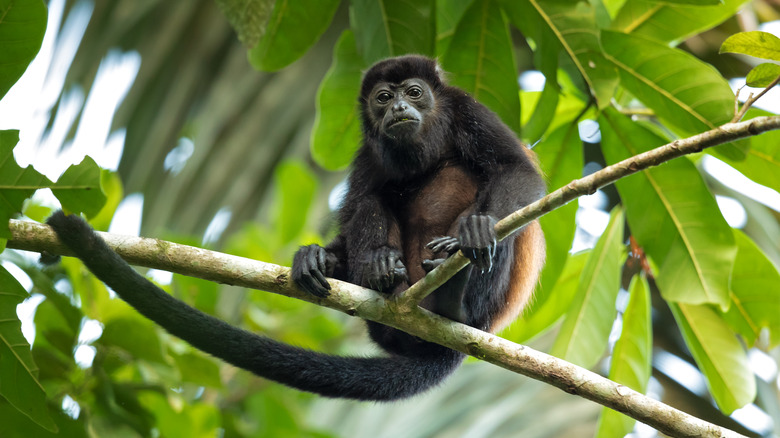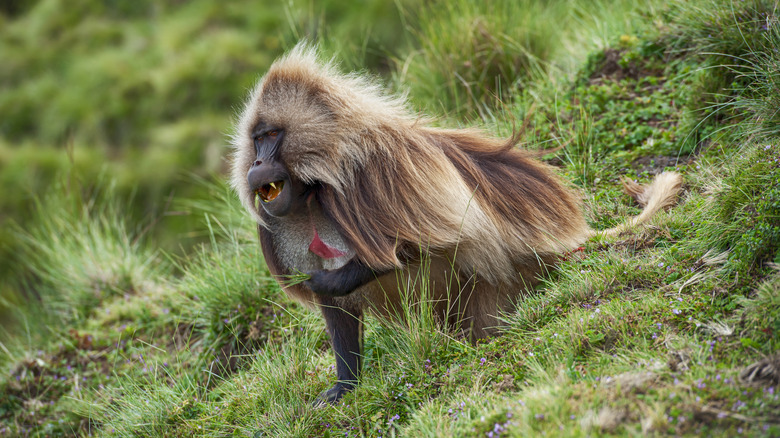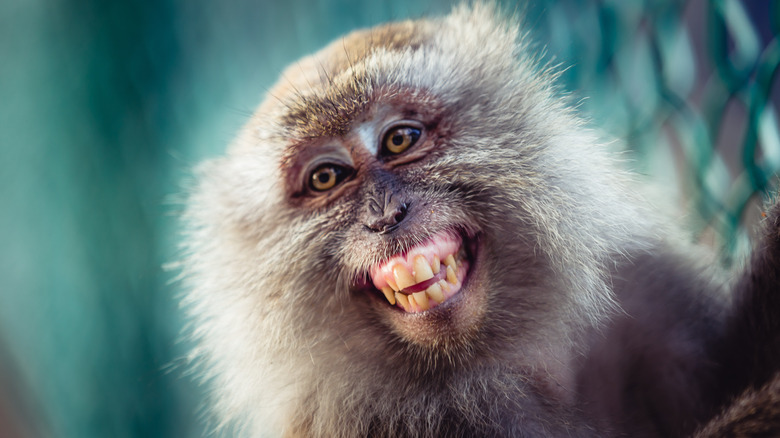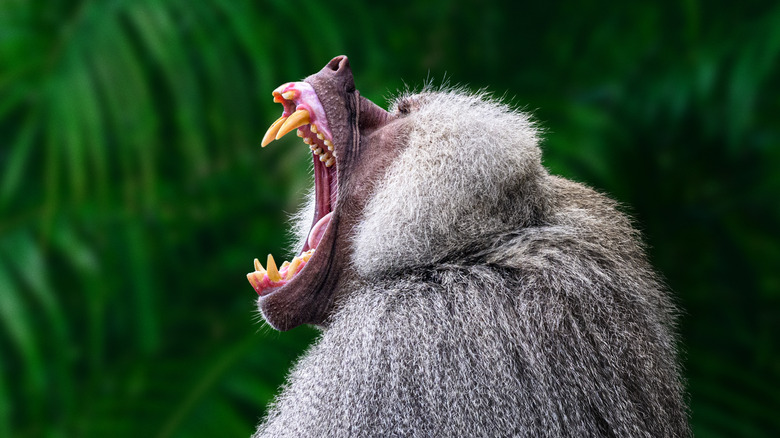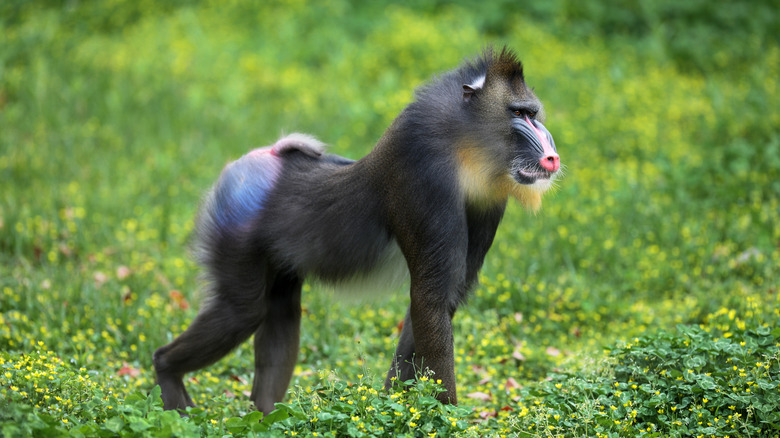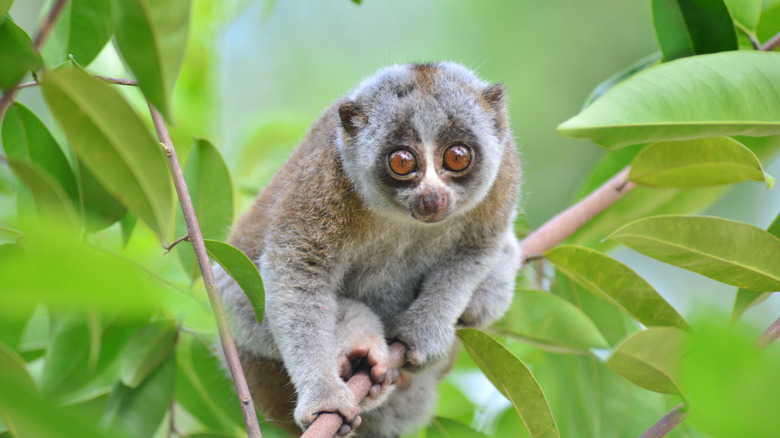11 Types Of Monkeys, Ranked By Danger Level
There are fair arguments to be made over which types of monkeys are the most dangerous. Parents might argue that toddlers are the most ferocious monkeys on the planet. As their feral nature can only be brooked by offerings of snacks and toys, a toddler's wild behavior is often equated with that of our primate cousins. This is, however, unfair to actual monkeys, who are a lot smarter than people give them credit for.
Still, they are wild animals. This designation comes with a degree of caution. Yes, monkeys, like the capuchin and slow loris, are excessively cute. However, seeing as one has the ability to scratch and bite, and the others' saliva can easily melt your skin, you can see the degree to which even the cutest of creatures can be considered dangerous.
Interactions with monkeys are common across the globe and are on the rise in the United States. People, therefore, need to know what they might be interacting with. Our ranking, which runs from least to most dangerous, takes into account factors like aggression, physicality, and the severity an attack would have on a human. Smart, fast, and, in some cases, downright scary, here are 11 types of monkeys ranked by danger level.
11. Bald uakaris seem more dangerous than they are
A vulnerable species native to the Amazon jungles of Peru and western Brazil, the bald uakari is not what you think of when you think of a monkey. Most of us are accustomed to the hairy, human-like faces of chimpanzees and gorillas, so the visage of the bald uakari offers a striking difference. With a bright red, hairless face, the sight of one of these monkeys can easily shock those who are not prepared for it. It's this surprise factor that can make the bald uakari seem more dangerous than it actually is.
The bald uakari is an extremely shy primate. Preferring to keep to itself, the bald uakari is among the more docile of primates, and is certainly the most timid of the monkeys on this list. They would rather leave you alone than attack you. The only thing they might do that seems aggressive will be to show off their sizable canines, but that's just their way of telling someone to back off.
If you do happen to come across one of these incredibly rare monkeys, you are really only going to be in for a bit of a jump at the sight of their bright red face peering through the trees. Otherwise, they are among the least dangerous creatures to beware of in the Amazon.
10. Violent interactions with Japanese macaques are becoming more common
Thanks to their ability to acclimatize themselves to colder environments, this particular breed of macaque is also known as the Japanese snow monkey. Found on almost every island in Japan, the Japanese macaque has one of the more sizable primate populations on this list. A medium sized monkey of about 25 pounds fully grown, Japanese macaques like to live in sizable troops, often ranging upwards of 170 monkeys per troop. As proof of their intelligence, these macaques have figured out that bathing in hot springs is a great way to stay warm in the winter.
Though they are a highly common sight across Japan, these macaques are not naturally inclined to bother people. However, due to the country's population density and ever-increasing human encroachment, violent interactions with people are becoming more commonplace.
Take the city of Yamaguchi, for example. According to the Independent, the city was beset by a large troop of incredibly violent snow monkeys for three weeks in 2022. 58 people reported being attacked, and there were stories of monkeys biting and punching people, breaking into homes, attacking school children, and even attempting to steal babies. No serious injuries were reported, but authorities did postulate that the attacks were likely due to increased monkey populations combined with habitat degradation.
9. Capuchin monkeys can be very destructive and territorial
Anyone who has watched "Night at the Museum" knows that capuchin monkeys can be a handful. However, despite the movie being a fantasy, the characteristics of the lead monkey are nevertheless extremely accurate. Capuchins are known for their cunning strategy, especially when it comes to handling those who are aggravating them. Add to this their extreme territoriality, and the aggression they can show to intruders is something to behold. Biting, scratching, and attempted maiming are not uncommon.
This is why capuchins are not recommended as pet animals. According to NBC News, despite their miniature stature, pet capuchin monkeys have a tendency to turn on their owners. When they reach sexual maturity at around five years old, they can become extremely destructive and dangerous to those trying to domesticate them.
Because of the threat they pose to public and private health, it is illegal to keep primates of any kind as pets in 26 states. While a capuchin is not strong enough to tear the skin away from your face, its teeth and bite are sharp and powerful enough to take off a finger. So, while they may look the part of a cute, innocent monkey, capuchins are anything but.
8. Spider monkeys can sometimes have a vicious temper
Thanks to their long and gangly arms, spider monkeys are experts at swinging through the trees of the South and Central American jungles they call home. Coming in an array of different colors, these primates compete with the capuchin and slow loris for the cutest monkey on this list. These small monkeys with wide faces and big, emotive eyes are at their most docile when they are members of large troops. They do not take well to isolation.
As reported by The Columbus Dispatch, spider monkeys that have been kept in isolation as pets, and even in zoos, display extremely violent behavior towards their human keepers. Isolated spider monkeys will frequently attempt to bite and choke whoever comes near them.
This behavior does not translate to wild, socialized spider monkeys in nearly the same extremes. Caution should nevertheless be taken when dealing with wild spider monkeys. They can have a vicious temper, and will go after anything and anyone that invades their space or makes them feel threatened. Add to that a viciously loud call, and you could be left with bite marks, and a ringing in your ears for days to come.
7. Rhesus macaques will use their sharp teeth and strength if provoked
A common sight on temple grounds and busy street corners in Asia, the rhesus macaque is a small monkey that inhabits some of the most densely populated places on the planet. This includes nations like Thailand, India, Vietnam, and even states like Florida, where they are considered to be an invasive species. As a result of this closeness, rhesus macaques have no great fear of people, which can lead to issues.
Though not aggressive by nature, in certain circumstances, the rhesus macaque will use its considerable strength and sharp teeth to defend against threats. When a rhesus macaque is cornered, they will lash out, biting, tearing, and scratching their perceived attacker. These monkeys can leave lasting damage in more ways than one.
According to The Washington Post, Florida's rhesus macaque population are known harbingers of a fatal strain of herpes. This means that should a Floridian or other resident get in a scuffle and end up scratched or bitten, they could become infected with herpes and become seriously ill or die as a result. So, while not as temperamental like some other monkeys, the potential damage a rhesus macaque can cause is right up there.
6. Howler monkeys are dangerous for the diseases they spread
Like their macaque cousins, howler monkeys are not outwardly aggressive towards humans. However, it is not so much the physicality of a howler monkey that is particularly dangerous. The diseases these monkeys are capable of spreading are among some of the more dangerous in the world. Howler monkeys, not mosquitoes, are the chief spreaders of malaria to human populations.
According to The Guardian, researchers in South America linked three separate outbreaks in 2006, 2015, and 2016 to zoonotic malaria spread by howler monkeys. Those who came down with the disease were mostly middle-aged men who enjoyed spending time wandering in the forest. The World Conservation Society also noted that howler monkeys were among the chief spreaders of yellow fever in Argentina in 2007.
One other thing to watch out for when it comes to howler monkeys is, well, their howl. If one howls next to your ear, it is loud enough to cause permanent hearing loss. According to the National Zoo, a howler monkey's cry can be heard from as far as three miles away. In comparison, a compressed air horn can only be heard from about a mile away.
5. Geladas contribute to devastating food shortages due to their appetites
Like the bald uakari, the gelada is one of the world's more visually unique monkeys. With a flowing mane of hair like that of a lion and the bright red, hourglass markings on their broad chests, geladas have a stately yet beast-like appearance. Add their gleaming red eyes and enormous canines to the mix, and you have one of the more intimidating-looking monkeys on the planet.
Natives of the Ethiopian Highlands, gelada monkeys' teeth do not seem suited to their diet. With those massive canines, one would assume the gelada to be a carnivore. However, they prefer to eat grasses and other vegetation. They like the stuff so much that they often find themselves chewing away at the crop of a farmer's field, which can lead to trouble.
If it felt inclined, the gelada could certainly do some physical damage to a person. They are strong, fast, and have powerful bites. However, they do much more damage to crops than they do to people. As such, since a group can devastate a whole field's worth of crops in an afternoon, these monkeys pose a significant threat to the lives and well-being of the nearby human populations due to food loss.
4. Crab-eating macaques will turn violent if they don't get what they want
Crab-eating macaques are no exception to Florida's invasive species problem. Small monkeys with a penchant for theft, the crab-eating macaque will very often steal people's possessions and then use said possessions as collateral for getting food. These actions may seem mildly amusing, but if the monkeys don't get what they want, things can turn violent quickly.
If a crab-eating macaque doesn't get what it wants from you, it will attack and bite, leaving you far worse than when you started off. To make matters even worse, crab-eating macaques are another species that are likely to carry the same deadly strain of herpes that the rhesus macaques carry. As such, they have been labeled an incredibly dangerous invasive species by the state of Florida, according to PennState.
Another component of the invasiveness of the species is the damage they cause to natural habitats. At home in Asia, crab-eating macaques are part of the ecosystem, eating the native crabs and seafood. In Florida, they cause harmful degradation to the native wildlife populations, causing issues with the survival of the national ecosystem.
3. Be careful around baboons, as they can retaliate aggressively
There are several different types of baboon species, and all of them have the potential to kill humans. Note this word: potential. As of yet, there are no recorded instances of baboons killing human beings. However, the potential can make them a very dangerous monkey. All you need to do is observe their size, speed, and strength.
While baboons are not likely to simply attack humans, they will retaliate aggressively if caught off guard or if you make seemingly threatening gestures. However, the attack is likely not to be anything more than a defensive swipe and some low howling.
Where baboons do pose a threat, particularly in Africa, are to crops and livestock. As they are mainly grass eaters, baboons will routinely attempt to eat the wheat and barley crops of farmers. They are also known to kill and eat sheep on occasion. However, baboons are, overall, rather tame and timid around people. You just need to watch out because if you cross one, you're in trouble.
2. Look at Mandrills from afar, as they can be deadly if provoked
Though they like to keep to their own hordes, mandrills are not above defending themselves. However, this is extremely rare behavior because they will only act aggressively when threatened. Still, their looks are enough to make any reasonable person think twice before engaging with the largest monkey on Earth. Known for their colorful facial complexion, mandrills are natives of Africa and are recognizable for their unique bare bottoms. They tend to weigh upwards of 120 pounds, all of which is compact muscle.
Bearing this in mind, a mandrill is certainly capable of taking on a fully grown human and tearing them to shreds if the occasion calls for it. They will defend their territory against other animals with a ferocity that is unmatched by any other monkey. And seeing as they tend to live in hordes numbering up to 1,000, you could be in deep trouble if more than one decides your actions are threatening.
Like their baboon cousins, it is going to take a lot to make a mandrill go after you. It's this more docile and timid nature that has made them targets for poachers, and are therefore a vulnerable species. It is best to look at these monkeys from a distance.
1. The slow loris has a deadly and poisonous bite
The slow loris is, without question, the cutest monkey on this list. With massive eyes and an extremely small, fuzzy body, most would want nothing more than to cuddle these little guys for hours. This would be a mistake. Although slow lorises are extremely cute and generally affable, they carry one of the most dangerous bites in the entire animal kingdom.
Slow lorises are the only primates to have a bite that can be considered poisonous. According to The Smithsonian, the bite from a slow loris is powerful enough to rot and melt away flesh. Like a jellyfish sting, a slow loris bite can also cause anaphylactic shock. If not treated with immediacy, the bite of a slow loris, which is strong enough to pierce through bone, is going to kill you, and gruesomely. It is for this reason that it can be considered the most dangerous monkey in the world.
So, while none of the monkeys on this list are outwardly aggressive towards humans, the fact that they can cause a decent amount of damage should be cause for concern. Taking into account the diseases they carry, as well as the potential to be poisoned by one, you have yourself a list of monkeys that should not be trifled with.
